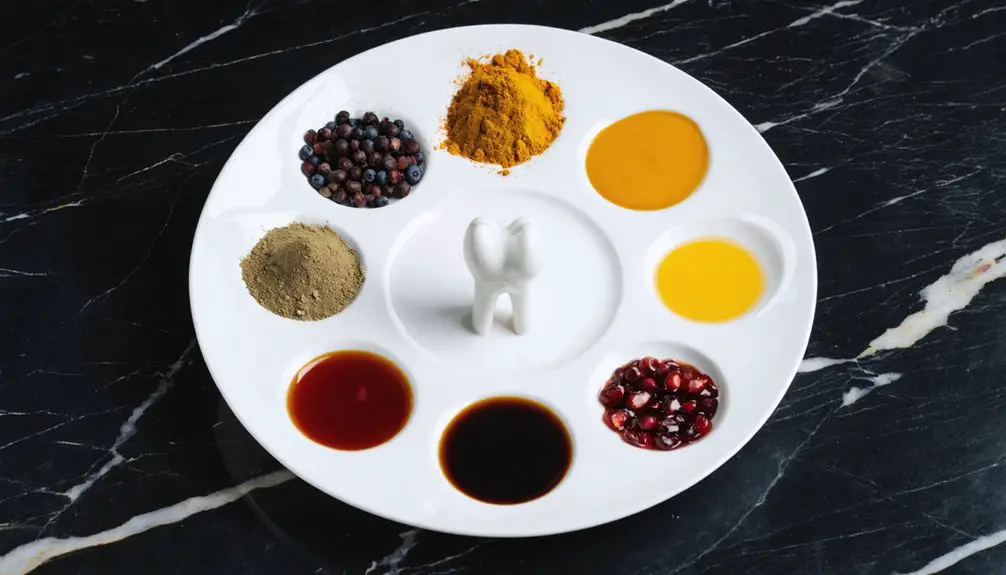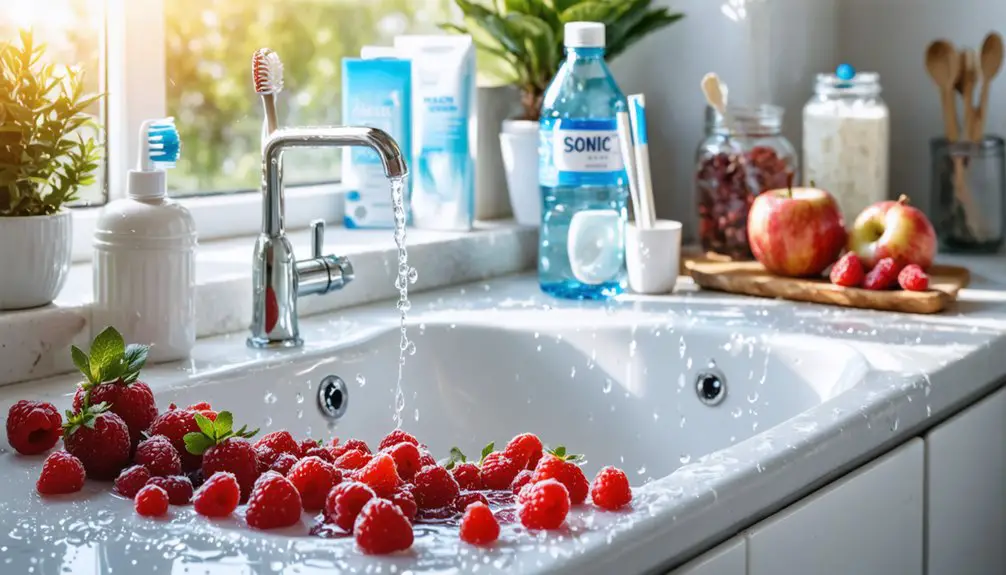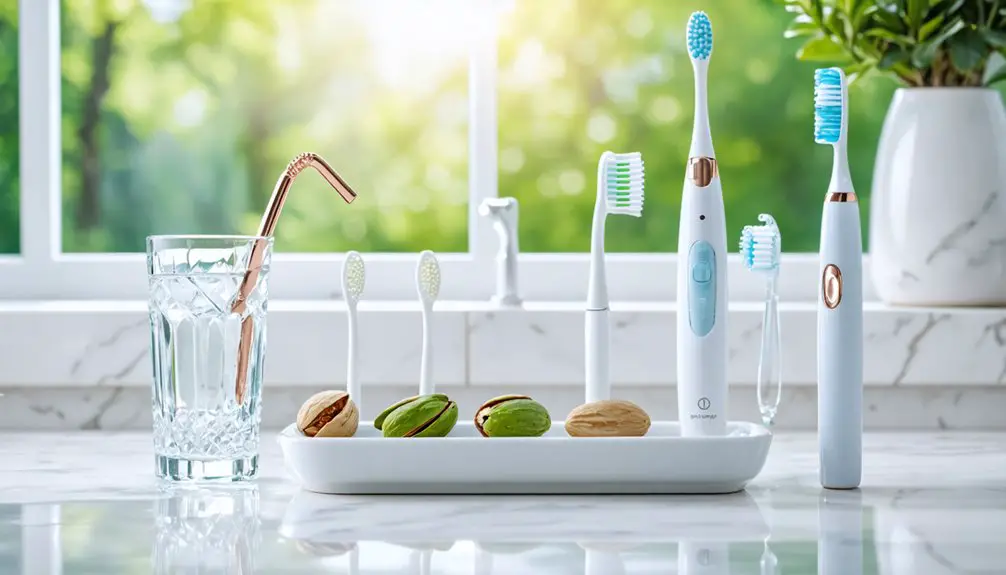Your teeth can develop saffron-like discoloration from common foods and drinks containing staining compounds. The major culprits include coffee, black tea, red wine, turmeric, curry powder, dark berries, tomato sauces, balsamic vinegar, soy sauce, and energy drinks. These items contain chromogens, tannins, and acids that bond to tooth enamel, causing yellow to orange staining. Understanding the specific mechanisms behind dental staining can help you protect your smile’s natural whiteness.
Key Takeaways
- Saffron, turmeric, and curry powders contain natural pigments that bond strongly to tooth enamel, causing yellow-orange staining.
- Black tea contains high levels of theaflavins that create significant dental discoloration, especially when consumed regularly.
- Dark berries and tomato products combine chromogens with acidity to create persistent tooth staining.
- Balsamic vinegar’s sticky texture and high acidity weaken enamel, allowing dark pigments to penetrate deeply.
- Coffee, particularly medium roasts, causes progressive yellowing of teeth through continuous exposure to staining compounds.
Understanding Saffron-Like Teeth Stains
When saffron and similar spices come into contact with your teeth, they release potent natural pigments that bond strongly to tooth enamel, resulting in a distinctive yellowish discoloration.
These saffron pigments, along with those found in turmeric and curry powders, are particularly challenging to remove once they’ve adhered to your teeth’s surface. Professional whitening treatments can effectively target these stubborn spice-based stains.
The staining process becomes more severe when acidic foods and beverages are involved.
Enamel erosion from acids weakens your teeth’s protective layer, making them more susceptible to pigment absorption. This damage exposes the naturally yellow dentin beneath and creates a surface that readily accepts stains.
When combined with poor oral hygiene, plaque buildup provides an additional surface for these pigments to bond with, intensifying the discoloration’s persistence. Regular dental cleaning every 6-12 months can help prevent and manage these stubborn stains.
The Impact of Coffee and Tea on Tooth Color
Your daily consumption of coffee and tea leads to progressive yellowing of teeth through the binding of tannins and theaflavins to tooth enamel, with black tea causing the most severe discoloration.
Recent studies using advanced analytical techniques have shown that theaflavin content is the primary cause of black tea’s pronounced staining effects.
You can protect your teeth by using a straw, rinsing with water after consumption, and maintaining proper oral hygiene with fluoride toothpaste and regular dental cleanings.
Cavity-causing bacteria thrive on sugary additives commonly used in coffee and tea drinks.
While immediate staining is concerning, the acidic nature of these beverages poses a greater long-term threat by eroding your enamel, making your teeth more susceptible to deep staining and sensitivity.
Daily Staining Effects
Two popular beverages, coffee and tea, greatly affect tooth discoloration through distinct chemical mechanisms.
Your daily habits with these drinks can markedly impact staining intensity, as tea’s higher tannin content creates darker, more stubborn brown stains compared to coffee’s yellowish discoloration.
When you sip these beverages throughout the day, you’re exposing your teeth to prolonged contact with staining compounds, particularly if you’re a tea drinker who tends to consume over extended periods. The acidic environment created weakens tooth enamel, making it more vulnerable to staining.
Coffee’s organic compounds called tannins attach to tooth enamel and contribute to noticeable discoloration over time.
Your dietary choices regarding additives matter too – adding milk can reduce staining intensity by altering how pigments interact with your enamel, though it won’t completely prevent discoloration.
Medium-roast coffee typically causes more staining than light or dark roasts due to its ideal balance of color-changing compounds.
Prevention and Protection Tips
Despite their staining potential, coffee and tea drinkers can considerably reduce tooth discoloration through strategic preventive measures.
You’ll achieve better protection by adding milk to your beverages, as it modifies surface deposits and makes stains less resistant to removal. Limit steeping time for tea to reduce tannin concentration, and rinse your mouth with water immediately after consumption.
For effective stain removal, use specialized teeth whitening toothpaste that’s formulated without excessive abrasiveness. Persistent stains may require teeth whitening sessions to fully eliminate discoloration.
You’ll need to maintain consistent oral hygiene through regular brushing and flossing to prevent stain buildup in hard-to-reach areas. Schedule professional dental cleanings periodically, as they’re essential for removing stubborn stains, particularly those caused by black tea, which bind more strongly to tooth surfaces.
Long-Term Enamel Damage
While preventive measures can minimize staining, understanding the long-term effects of coffee and tea on tooth enamel reveals more serious concerns. Your daily consumption of these beverages can cause irreversible enamel erosion, exposing the darker dentin beneath. Sugar and syrups in coffee and tea significantly increase the risk of decay through bacterial acid production. Black tea compounds can help fight harmful oral bacteria that cause decay and bad breath.
This damage isn’t just cosmetic – it makes your teeth more susceptible to decay and sensitivity.
- Enamel restoration becomes increasingly difficult as erosion progresses
- Acidic pH levels in coffee and tea continuously soften your protective enamel
- Tannins create persistent stains that bond strongly with weakened enamel
- Low saliva flow from caffeine intake accelerates bacterial growth
- Professional intervention becomes necessary as damage accumulates
Without proper dietary adjustments and protective measures, you’ll face increased tooth sensitivity, deeper staining, and greater vulnerability to cavities.
The combination of acid erosion and chromogenic compounds creates lasting damage that extends beyond surface discoloration.
Red Wine’s Role in Yellow Tooth Discoloration
As red wine passes over your teeth, its potent combination of tannins and chromogens creates a perfect storm for yellow tooth discoloration.
The acidic nature of red wine softens your enamel, making it more vulnerable to pigment absorption, while tannins facilitate the binding of staining compounds to your tooth surface. Acidic pH softens dental enamel, creating an environment where stains can more easily develop.
You’ll find that darker, more tannic varieties like Syrah and Cabernet Sauvignon pose the greatest risk due to their higher concentration of staining agents.
The frequency and duration of your red wine consumption directly impact the severity of discoloration, especially when combined with poor oral hygiene.
While the staining primarily affects the outer enamel layer, prolonged exposure can lead to deeper penetration of pigments into microscopic enamel irregularities, making the discoloration more challenging to address through routine cleaning alone.
How Turmeric and Curry Affect Dental Appearance
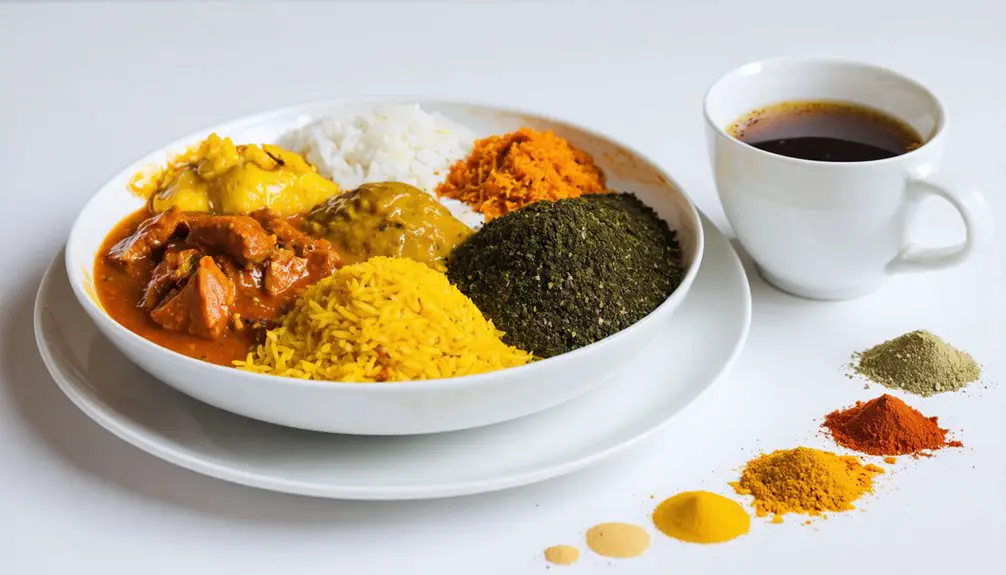
Your teeth’s exposure to turmeric and curry can lead to significant yellowing through their potent pigments, particularly curcumin, which binds strongly to dental enamel.
While curry’s acidic components can weaken enamel and create a more receptive surface for staining, turmeric’s dual nature as both a potential staining agent and oral health supporter presents a complex dynamic.
You’ll need to balance the beneficial anti-inflammatory and antimicrobial properties of these foods against their staining potential through proper oral hygiene practices and timing of consumption.
Staining Mechanisms of Turmeric
Understanding how turmeric causes dental discoloration requires examining its primary staining compound, curcumin. While turmeric toxicity isn’t a concern, this bioactive compound’s strong yellow-orange pigments readily adhere to your teeth’s surface, especially if you’ve experienced enamel erosion.
The staining process intensifies when essential oils in turmeric facilitate pigment retention, despite your saliva’s natural cleansing action.
Here’s how turmeric affects your teeth:
- Curcumin binds to surface irregularities in dental enamel
- Essential oils promote pigment adherence and retention
- Stains become trapped within existing dental plaque
- Repeated exposure leads to cumulative pigment buildup
- Surface roughness increases light diffusion, making stains more visible
Professional cleaning may be necessary to remove embedded stains, as turmeric’s pigments don’t respond to typical whitening methods.
Curry’s Long-Term Teeth Effects
Regular consumption of curry can lead to significant dental discoloration over time, primarily due to its rich concentration of staining compounds. If you’re consuming curry frequently, you’ll notice your teeth developing a yellowish to saffron-toned appearance, particularly from turmeric’s pigments and other spices like paprika and mustard seeds.
The combined effects of acidic ingredients and tannins in curry contribute to enamel erosion, making your teeth more susceptible to deep staining.
Curry consumption without proper oral hygiene can result in accumulated discoloration that’s difficult to remove through regular cleaning. You’ll find this effect more pronounced if you already have weakened enamel or existing acid damage.
The staining can mimic age-related discoloration and may require professional dental intervention to maintain your teeth’s natural white appearance.
Preventing Yellow Teeth Stains
While turmeric and curry dishes add vibrant flavors to meals, their strong pigments can greatly impact dental aesthetics through surface staining.
You’ll need to be proactive with your dietary choices and oral hygiene to maintain a bright smile. While some advocate natural remedies, professional dental care remains most effective for preventing discoloration.
Here’s what you can do to protect your teeth from yellow staining:
- Brush immediately after consuming turmeric or curry dishes
- Use whitening toothpaste twice daily with proper brushing technique
- Rinse your mouth thoroughly if brushing isn’t immediately possible
- Schedule professional cleanings every six months
- Consider using a whitening mouthwash as part of your routine
Dark Berries and Their Staining Properties
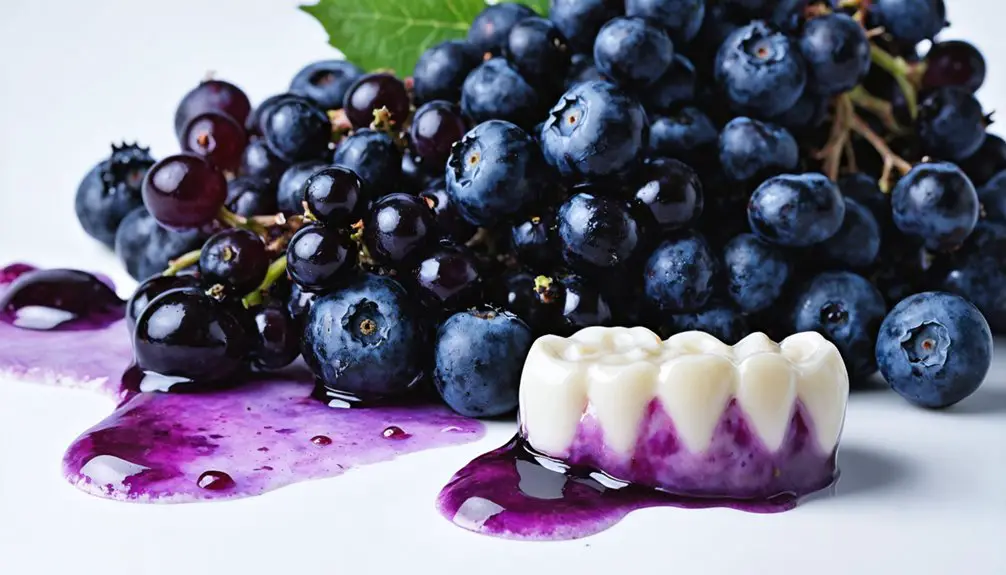
Dark berries pose a considerable threat to dental aesthetics due to their rich concentration of chromogens, naturally occurring pigmented compounds that readily bind to tooth enamel.
You’ll find that berry pigmentation varies considerably among different varieties, with blueberries and blackberries showing the highest staining severity due to their potent combination of chromogens and tannins.
The staining potential is further amplified by the berries’ natural acidity, which temporarily softens your enamel, making it more susceptible to discoloration.
While lighter berries like raspberries and strawberries cause less dramatic staining, they can still contribute to tooth discoloration over time.
To protect your patients’ smiles while allowing them to enjoy these nutritious fruits, recommend immediate rinsing with water after consumption and maintaining thorough oral hygiene practices.
The Hidden Dangers of Energy Drinks
Your favorite energy drinks pose multiple threats to your dental health, from their highly acidic content that rapidly erodes protective tooth enamel to their concentrated sugar levels that fuel decay-causing bacteria.
The combination of acid erosion and sugar exposure creates a perfect environment for long-term dental damage, making your teeth more susceptible to staining from artificial dyes and colorants present in these beverages.
The damage isn’t immediately visible, but over time, your weakened enamel becomes increasingly porous, allowing staining agents to penetrate deeper and create stubborn discoloration that’s difficult to reverse.
Dental Enamel Under Attack
When it comes to dental health threats, energy drinks pose one of the most serious risks to tooth enamel integrity. Your teeth’s protective layer faces severe energy drink effects, with erosion rates twice that of regular sodas.
You’ll experience approximately 3.1% enamel loss in just five days of exposure, making proper enamel protection essential for maintaining dental health.
Key factors that intensify enamel damage from energy drinks:
- pH levels well below the critical 5.5 threshold
- Caffeine-induced dry mouth reducing protective saliva
- Combined assault of acids and sugars
- Irreversible nature of enamel loss
- Heightened vulnerability in younger teeth
To protect your enamel, wait 30 minutes before brushing after consumption, use a straw, and avoid frequent sipping.
These measures help minimize direct contact between acidic compounds and your teeth’s surface.
Hidden Sugar Content Dangers
The hidden sugar content in energy drinks poses a severe metabolic health risk, with many products containing up to 20 teaspoons (78g) of sugar per 500ml serving.
These levels exceed the recommended adult daily free sugar intake by over three times, contributing to obesity, type 2 diabetes, and cardiovascular disease.
You’ll find that despite some manufacturers’ efforts to reduce sugar content, many energy drinks still contain between 14 and 17 teaspoons per serving.
The rapid absorption of these sugars triggers sharp blood sugar spikes, stressing your metabolic health and increasing your risk of sugar addiction.
Even more concerning, brands often increase portion sizes to compensate for sugar reductions per 100ml, maintaining dangerously high total sugar intake levels.
The replacement of sugar with non-caloric sweeteners, without clear labeling changes, can leave you unaware of actual sugar content.
Long-Term Staining Effects
Regular consumption of energy drinks initiates a devastating cascade of dental damage, primarily through aggressive enamel erosion that occurs at rates considerably higher than other acidic beverages.
As energy drink acidity weakens your tooth structure, dark pigments penetrate deeper into the compromised enamel, creating stubborn stains that regular brushing can’t remove.
- Enamel erosion occurs twice as fast compared to sports drinks
- Porous, weakened enamel allows deeper stain penetration
- Dark pigments and dyes adhere strongly to eroded surfaces
- Professional cleaning may be required to remove set-in stains
- Even sugar-free varieties cause significant enamel damage
The combined effects of enamel erosion and staining can permanently alter your smile’s appearance, often requiring extensive cosmetic dentistry to restore natural tooth color and brightness.
Tomato-Based Products and Tooth Discoloration
Despite their nutritional benefits, tomato-based products pose significant risks to dental health through a dual mechanism of acid erosion and pigment staining.
While tomatoes offer vital nutrients, they can harm your teeth by both eroding enamel and staining the surface through acidic damage.
You’ll find that tomato acidity gradually erodes your tooth enamel, creating microscopic pores that become vulnerable to chromogen binding from the intense red pigments found in these foods.
The effects worsen with prolonged exposure, particularly when consuming sticky tomato sauces that cling to your teeth.
While raw tomato juice contains enzymes that may offer some whitening properties, cooked tomato products typically cause more staining due to their concentrated pigments and acidic nature.
You’ll need to be especially mindful of frequent consumption of foods like pizza or pasta with tomato sauce, as they can lead to cumulative enamel damage and persistent discoloration.
Balsamic Vinegar’s Effect on Dental Whiteness
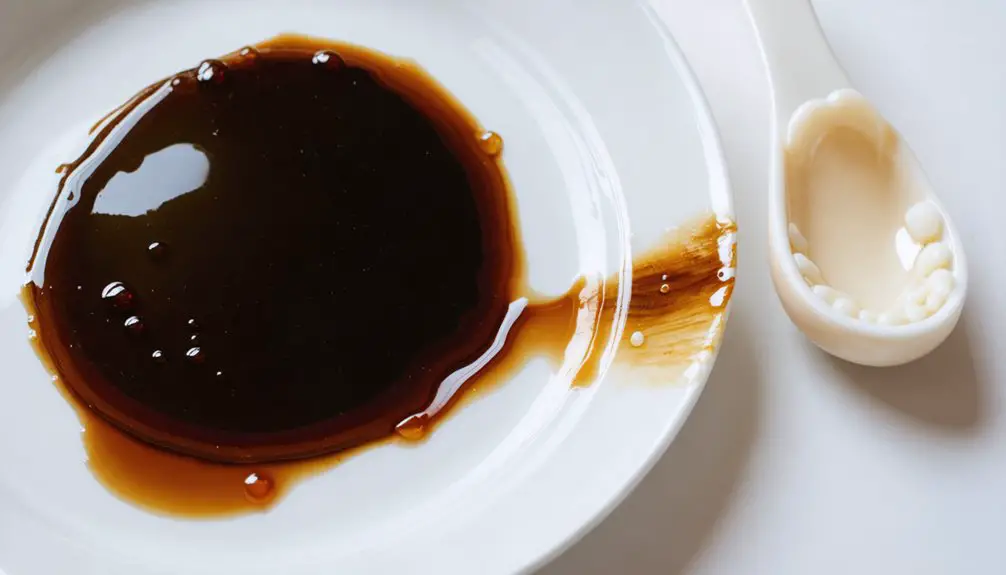
Much like tomato-based products, balsamic vinegar poses a significant threat to dental whiteness through its dual action of acid erosion and chromogen staining. The high acidity weakens your tooth enamel while dark chromogens bind to the surface, creating lasting discoloration.
Balsamic vinegar effects are particularly concerning due to its sticky nature, which prolongs contact with teeth.
- Rinse your mouth thoroughly with water after consuming balsamic vinegar
- Combine balsamic dressings with crunchy vegetables to help clean teeth
- Use fluoride toothpaste to strengthen enamel against erosion
- Limit frequency and duration of exposure to prevent staining
- Consider lighter-colored vinegar alternatives when possible
To minimize enamel erosion, don’t brush immediately after consumption. Instead, wait 30 minutes and pair balsamic vinegar with dairy products to help neutralize acids.
Soy Sauce and Other Dark Condiments
When dark condiments like soy sauce come into contact with your teeth, their concentrated pigments and tannins can quickly lead to visible staining. The chromogens in soy sauce readily bind to your tooth enamel, while the sauce’s acidity weakens the protective surface, allowing deeper penetration of staining agents.
Dark sauces contain staining compounds that bond to tooth surfaces, while their acids break down protective enamel, causing lasting discoloration.
You’ll want to take preventive measures when using dark sauces in your cooking. Rinse your mouth with water immediately after consumption, and wait 30 minutes before brushing to protect your enamel.
Consider switching to lighter alternatives like teriyaki or cream-based sauces when possible. For ideal protection, use a straw when consuming liquid dark sauces, and maintain consistent oral hygiene practices.
Professional dental cleanings can effectively remove stubborn stains caused by regular dark sauce consumption.
Preventive Tips for Maintaining White Teeth
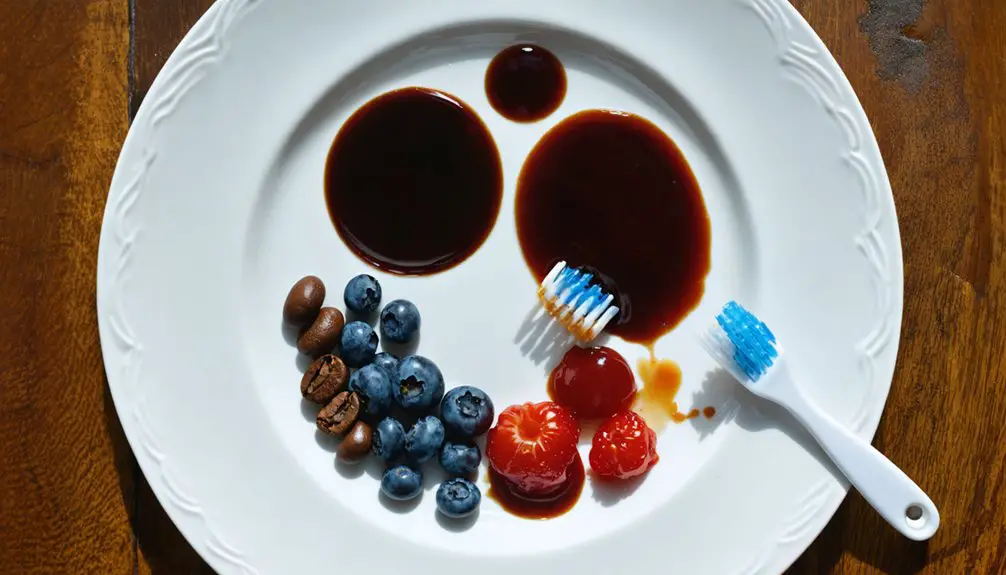
While dark condiments pose staining risks, implementing specific preventive measures can effectively protect your teeth’s natural whiteness. Incorporating daily preventive habits and using appropriate whitening products can considerably reduce discoloration risks.
When consuming acidic or pigmented beverages, use a straw to minimize contact with teeth, and wait 30-60 minutes before brushing to prevent enamel damage.
- Brush teeth twice daily with fluoride-containing whitening toothpaste
- Rinse your mouth with water after consuming staining foods or drinks
- Use whitening mouthwash and sugar-free gum to stimulate saliva production
- Add milk to tea or coffee to reduce staining potential
- Schedule regular professional cleanings for stubborn stain removal
Remember to floss daily and maintain consistent oral hygiene practices to preserve your smile’s brightness while protecting your enamel’s integrity.
Frequently Asked Questions
Can Teeth Whitening Strips Remove Deep-Set Saffron Stains Effectively?
You’ll find whitening strips aren’t highly effective for deep-set saffron stain removal. While they may lighten surface discoloration, professional treatments are recommended for thoroughly addressing stubborn saffron stains in your teeth.
How Long After Eating Staining Foods Should I Wait Before Brushing?
You’ll need to wait 30-60 minutes before brushing to protect against teeth sensitivity. During this time, your enamel can reharden, allowing for safer brushing techniques without damaging softened surfaces.
Do Whitening Toothpastes Prevent Yellow Stains From Forming on Teeth?
You’ll get limited prevention from whitening toothpaste ingredients, as they primarily remove existing stains rather than block new ones. For ideal whitening effectiveness, combine with proper brushing timing and technique.
Are There Natural Foods That Help Counteract Tooth Staining Effects?
You’ll find natural remedies in crunchy fruits and vegetables that help prevent stains through scrubbing action. Apples, strawberries, and pineapples contain acids that naturally whiten while promoting stain prevention.
Can Professional Dental Cleaning Remove All Types of Food-Related Tooth Discoloration?
Professional cleaning can remove most surface food stains through stain removal techniques, but won’t eliminate deep intrinsic discoloration. You’ll need additional dental maintenance procedures for complete whitening results.
References
- https://southeasterndentalcenter.com/foods-that-cause-teeth-stains/
- https://dentalcareprofessionals.com.au/what-causes-yellow-teeth-and-teeth-discolouration
- https://www.brauerfamilydentistry.com/blogs/foods-that-stain-your-teeth
- https://berwyndentalconnection.com/foods-and-drinks-that-stain-your-teeth/
- https://www.batonrougedentistry.com/ask_dentist.php?action=view&story_id=8
- https://www.datelinehealthafrica.org/yellow-teeth-and-other-discolourations-in-africans-causes-and-treatment
- https://dentspa.com/blog/tooth-discoloration/
- https://serenedentalspa.com/watch-out-for-these-teeth-staining-foods/
- https://salempediatricdental.com/7-surprising-foods-staining-teeth/
- https://www.itjfs.com/index.php/ijfs/article/view/2715
